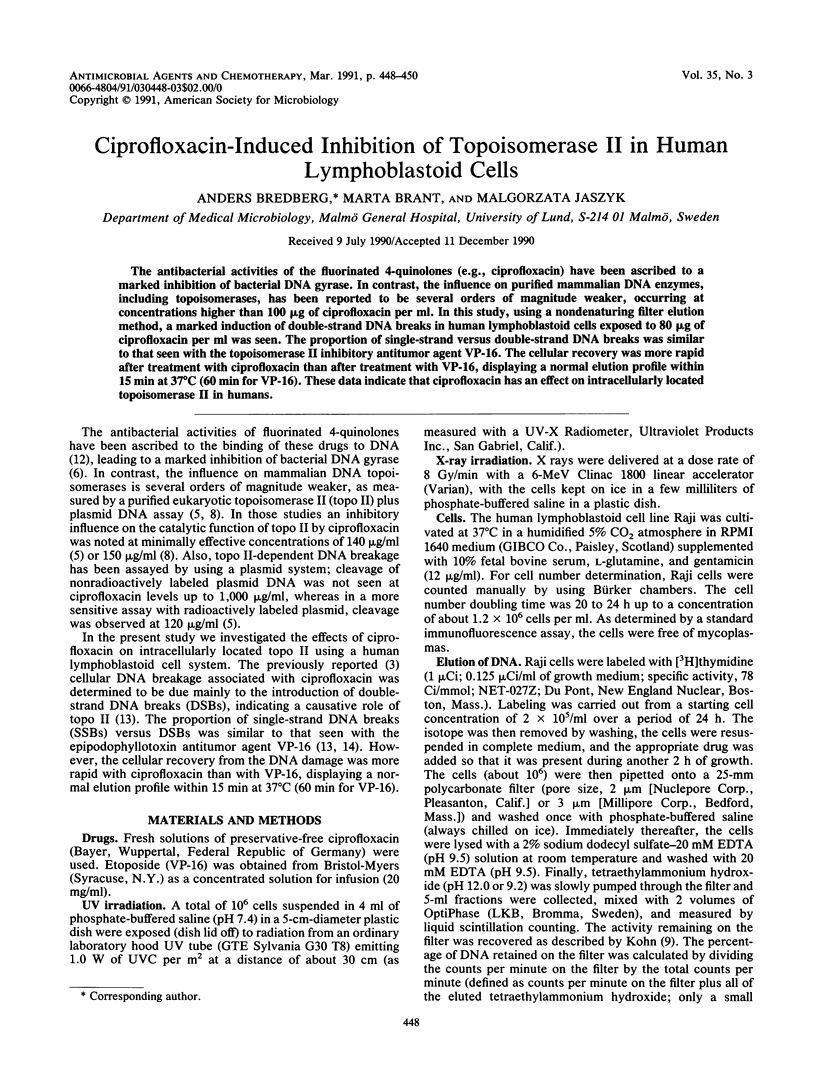Abstract
The antibacterial activities of the fluorinated 4-quinolones (e.g., ciprofloxacin) have been ascribed to a marked inhibition of bacterial DNA gyrase. In contrast, the influence on purified mammalian DNA enzymes, including topoisomerases, has been reported to be several orders of magnitude weaker, occurring at concentrations higher than 100 micrograms of ciprofloxacin per ml. In this study, using a nondenaturing filter elution method, a marked induction of double-strand DNA breaks in human lymphoblastoid cells exposed to 80 micrograms of ciprofloxacin per ml was seen. The proportion of single-strand versus double-strand DNA breaks was similar to that seen with the topoisomerase II inhibitory antitumor agent VP-16. The cellular recovery was more rapid after treatment with ciprofloxacin than after treatment with VP-16, displaying a normal elution profile within 15 min at 37 degrees C (60 min for VP-16). These data indicate that ciprofloxacin has an effect on intracellularly located topoisomerase II in humans.
Full text
PDF


Selected References
These references are in PubMed. This may not be the complete list of references from this article.
- Bae Y. S., Kawasaki I., Ikeda H., Liu L. F. Illegitimate recombination mediated by calf thymus DNA topoisomerase II in vitro. Proc Natl Acad Sci U S A. 1988 Apr;85(7):2076–2080. doi: 10.1073/pnas.85.7.2076. [DOI] [PMC free article] [PubMed] [Google Scholar]
- Bradley M. O., Kohn K. W. X-ray induced DNA double strand break production and repair in mammalian cells as measured by neutral filter elution. Nucleic Acids Res. 1979 Oct 10;7(3):793–804. doi: 10.1093/nar/7.3.793. [DOI] [PMC free article] [PubMed] [Google Scholar]
- Bredberg A., Brant M., Riesbeck K., Azou Y., Forsgren A. 4-Quinolone antibiotics: positive genotoxic screening tests despite an apparent lack of mutation induction. Mutat Res. 1989 Mar;211(1):171–180. doi: 10.1016/0027-5107(89)90117-6. [DOI] [PubMed] [Google Scholar]
- Hussy P., Maass G., Tümmler B., Grosse F., Schomburg U. Effect of 4-quinolones and novobiocin on calf thymus DNA polymerase alpha primase complex, topoisomerases I and II, and growth of mammalian lymphoblasts. Antimicrob Agents Chemother. 1986 Jun;29(6):1073–1078. doi: 10.1128/aac.29.6.1073. [DOI] [PMC free article] [PubMed] [Google Scholar]
- Ross W. E., Bradley M. O. DNA double-stranded breaks in mammalian cells after exposure to intercalating agents. Biochim Biophys Acta. 1981 Jun 26;654(1):129–134. doi: 10.1016/0005-2787(81)90145-3. [DOI] [PubMed] [Google Scholar]
- Shen L. L., Kohlbrenner W. E., Weigl D., Baranowski J. Mechanism of quinolone inhibition of DNA gyrase. Appearance of unique norfloxacin binding sites in enzyme-DNA complexes. J Biol Chem. 1989 Feb 15;264(5):2973–2978. [PubMed] [Google Scholar]
- Wang J. C. Recent studies of DNA topoisomerases. Biochim Biophys Acta. 1987 Jun 6;909(1):1–9. doi: 10.1016/0167-4781(87)90040-6. [DOI] [PubMed] [Google Scholar]
- Wozniak A. J., Ross W. E. DNA damage as a basis for 4'-demethylepipodophyllotoxin-9-(4,6-O-ethylidene-beta-D-glucopyranoside) (etoposide) cytotoxicity. Cancer Res. 1983 Jan;43(1):120–124. [PubMed] [Google Scholar]


